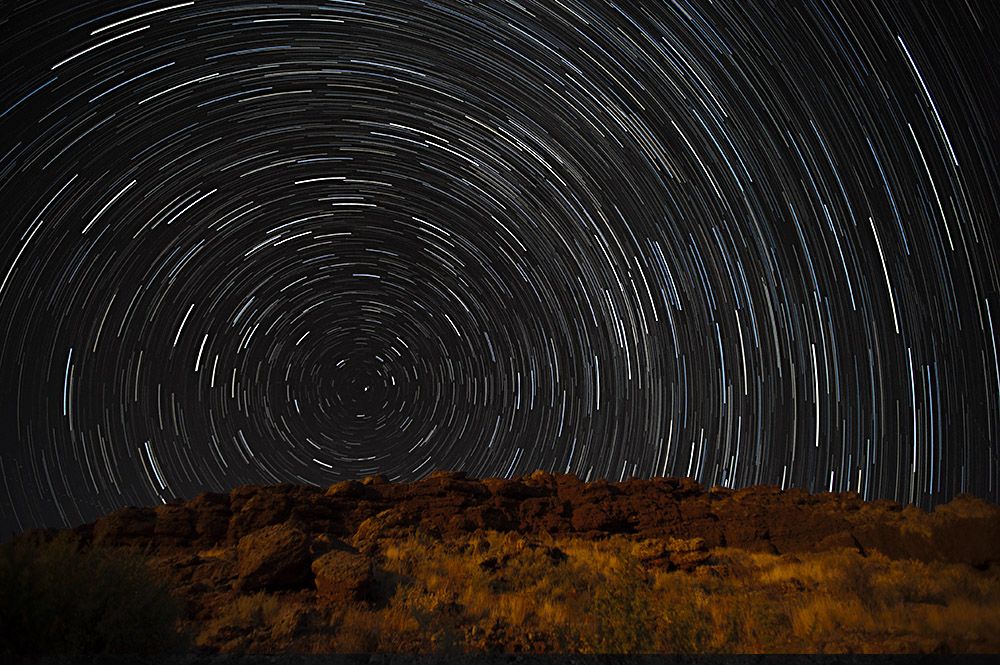You are using an out of date browser. It may not display this or other websites correctly.
You should upgrade or use an alternative browser.
You should upgrade or use an alternative browser.
Light trails
- Thread starter bikeit
- Start date
Are you referring to "Star Trails"? If so, there are several good "how to" videos on YouTube on how to do it. One can be found here
"Light pollution" must be ZERO. A cold, clear and moonless night is ideal. I set my ISO on 1250 and find the North Star. All stars rotate around the North Star, or Polaris. I set up the camera to take about 150 - 30 second exposures @ f/5.6 but you may need to tweak it for your area. The easiest way I have found to do this, even though the D700 has a built in intervalometers, is to set the camera on Continous (High) and use a remote shutter release to lock open the shutter. As soon as the shutter closes, it will cycle again and the shutter will open again for another 30 seconds, and so on and so on. You can use something light Lightroom to tweak one image, getting the blacks as deep as possible, and then synching all of the images.
I use a program called StarStax and it works perfectly. Make sure you select "gap filling" when you set it up. Also, if you are out on a cold night, remember that your batteries will not last you as long as they normally would. Have a spare set ready to go. DO NOT move the camera when changing the batteries or all will be lost and you will have to start over. It is far easier to change the batteries in a grip then it is to open up the door on the underside of the camera.

"Light pollution" must be ZERO. A cold, clear and moonless night is ideal. I set my ISO on 1250 and find the North Star. All stars rotate around the North Star, or Polaris. I set up the camera to take about 150 - 30 second exposures @ f/5.6 but you may need to tweak it for your area. The easiest way I have found to do this, even though the D700 has a built in intervalometers, is to set the camera on Continous (High) and use a remote shutter release to lock open the shutter. As soon as the shutter closes, it will cycle again and the shutter will open again for another 30 seconds, and so on and so on. You can use something light Lightroom to tweak one image, getting the blacks as deep as possible, and then synching all of the images.
I use a program called StarStax and it works perfectly. Make sure you select "gap filling" when you set it up. Also, if you are out on a cold night, remember that your batteries will not last you as long as they normally would. Have a spare set ready to go. DO NOT move the camera when changing the batteries or all will be lost and you will have to start over. It is far easier to change the batteries in a grip then it is to open up the door on the underside of the camera.

Assuming you mean from head and tail lights. Well a tripod is a must being your dragging the shutter. I would start with around an f8 low ISO and just experiment with the shutter to get the look you want. Once you figure the right shutter speed, lock it in and adjust the F-stop and or the ISO till the exposure is right.
Have a look at this link for some info
http://nikonites.com/general-photog...ail.html?highlight=light+trails#axzz3JdGtXdjk
http://nikonites.com/general-photog...ail.html?highlight=light+trails#axzz3JdGtXdjk
Thanks folks, Paul the shutter speed in your second photos are 13/1 and 18/1 is this minutes, in bulb mode sttting? STM brilliant photos you have there.
its in seconds.
if you try 10 seconds you might have to adjust the aperture depending on the lens you use. I used a 50mm F1.8 lens
I will be using a 18/140mm lens, so i will fiddle around with the exposure time.
Try it at about 50mm, aperture at F22 and a time of 15 seconds and you should be ok, if the picture is to dark, then adjust the aperture to F18 and 15 seconds., let us know how you get on
